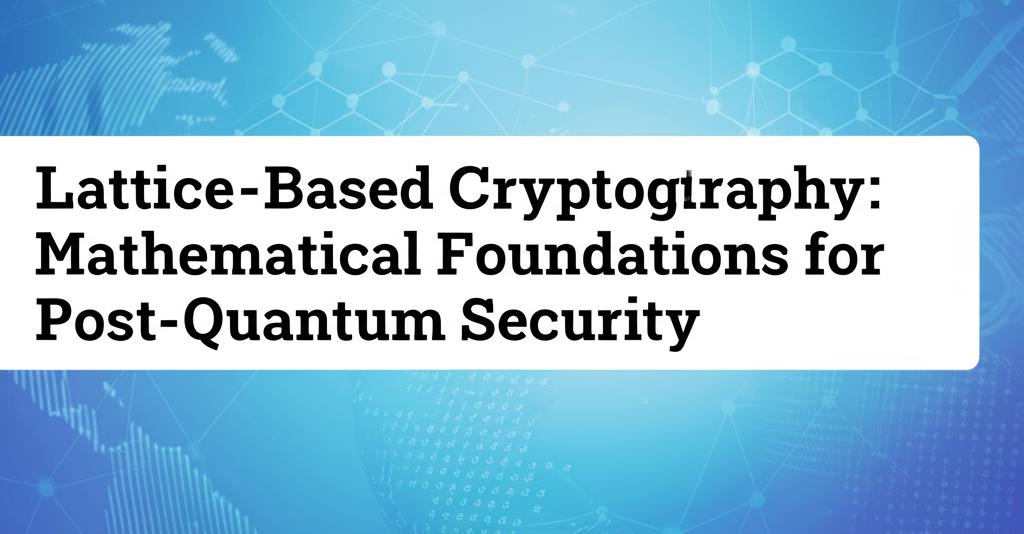Lattice-based cryptography is a leading approach in the development of post-quantum cryptography (PQC), designed to secure digital communications against the threat posed by quantum computers. Unlike current encryption methods like RSA and Elliptic Curve Cryptography (ECC), which are vulnerable to quantum attacks (specifically Shor's algorithm), lattice-based cryptography relies on mathematical problems that are believed to be hard for both classical and quantum computers to solve.
At its core, lattice-based cryptography uses lattices – which are essentially grids of points extending in multiple dimensions, formed by combining sets of vectors. The security of these systems stems from the computational difficulty of certain problems related to these lattices.
Key Mathematical Problems:The security of lattice-based cryptography relies on the presumed hardness of several mathematical problems:
- Shortest Vector Problem (SVP): Finding the shortest non-zero vector in a given lattice. While relatively solvable in low dimensions, the difficulty increases dramatically in higher dimensions (e.g., 1000+ dimensions), making it computationally infeasible even for quantum computers.
- Closest Vector Problem (CVP): Given a vector that is not part of the lattice, the problem is to find the vector within the lattice that is closest to the given vector. Similar to SVP, its complexity grows with the lattice's dimension.
- Learning With Errors (LWE): This problem involves solving a system of linear equations where small, random errors (or "noise") have been introduced. Recovering the original secret from these "noisy" equations is computationally hard. The LWE problem and its variants, like Ring-LWE (which uses algebraic structures for better efficiency), form the basis for many practical lattice-based cryptosystems.
- Shortest Integer Solution (SIS): This problem involves finding short, non-zero integer vectors that satisfy a particular matrix equation. It is closely related to LWE.
These problems are considered strong candidates for post-quantum security because no known polynomial-time quantum algorithms can solve them efficiently.
How Lattice-Based Encryption Works (Conceptual):In very general terms, lattice-based encryption schemes operate as follows:
- Key Generation: A private key is typically a "good" basis (a set of vectors that can generate the lattice and has desirable properties, like being relatively short and nearly orthogonal). The public key is derived from this private key, often by creating a "bad" basis (one that still generates the same lattice but is much harder to work with, for instance, by using longer, less orthogonal vectors or by hiding the structure with LWE noise). It should be computationally difficult to derive the private key from the public key.
- Encryption: To encrypt a message, the sender uses the public key to transform the message into a point that is close to a lattice point.
- Decryption: The recipient uses their private key (the "good" basis) to easily find the nearest lattice point to the encrypted message, thereby recovering the original message. Someone without the private key, working only with the public key (the "bad" basis), would find it very difficult to perform this step.
- Quantum Resistance: Its primary advantage is its presumed security against attacks from quantum computers.
- Versatility: It can be used to build a wide range of cryptographic tools, including public-key encryption, key encapsulation mechanisms (KEMs), digital signatures, and even more advanced applications like fully homomorphic encryption (which allows computations on encrypted data).
- Efficiency: Many lattice-based schemes offer performance comparable to, or even better than, existing classical algorithms, especially when using structured lattices like those in Ring-LWE.
- Security Foundations: Some lattice-based constructions come with security proofs based on worst-case hardness assumptions. This means breaking the cryptosystem is at least as hard as solving the underlying lattice problem in its hardest possible instance.
Lattice-based algorithms are typically represented using matrices, allowing for calculations using standard matrix operations. These vectors are often mapped into finite fields.
The National Institute of Standards and Technology (NIST) has been leading a process to standardize PQC algorithms. Lattice-based cryptography has emerged as a prominent family in this effort. Several lattice-based algorithms have been selected for standardization or are considered strong candidates. For example:
- CRYSTALS-Kyber (now ML-KEM): A key encapsulation mechanism chosen by NIST for general encryption.
- CRYSTALS-Dilithium (now ML-DSA): A digital signature algorithm also selected by NIST.
While lattice-based cryptography offers strong security and performance, one practical challenge has been that some schemes can have larger key sizes or ciphertext sizes compared to classical elliptic curve cryptography. However, ongoing research and optimization continue to address these aspects. For instance, establishing an encryption key with ML-KEM-768 requires more communication (around 2272 bytes) than a modern elliptic curve key exchange (around 64 bytes).
Recent developments (as of early 2025) include NIST finalizing the first set of PQC standards, including ML-KEM and ML-DSA. NIST is also evaluating backup algorithms based on different mathematical approaches to ensure resilience in case vulnerabilities are found in the primary standards. For instance, the Hamming Quasi-Cyclic (HQC) algorithm, based on error-correcting codes, has been selected as a backup for ML-KEM. Research continues to refine algorithms and explore new techniques to enhance security and efficiency further.
In summary, lattice-based cryptography provides a robust mathematical foundation for building cryptographic systems that can withstand the advent of quantum computing, ensuring the long-term security of digital information. Its strong theoretical underpinnings and practical performance have made it a cornerstone of the ongoing transition to post-quantum security standards.

